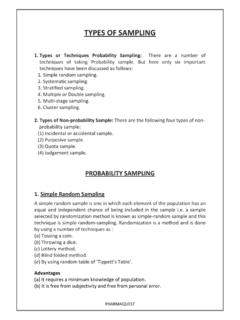Transcription of Social Stratification - LPU Distance Education (LPUDE)
1 Social StratificationDSOC202 Edited ByDr. Sukanya Das Social STRATIFICATIONE dited ByDr. Sukanya DasPrinted byUSI PUBLICATIONS2/31, Nehru Enclave, Kalkaji Ext.,New Delhi-110019forLovely Professional UniversityPhagwara CONTENT Unit 1: Understanding Social Stratification Rosy Hastir, Lovely Professional University 1 Unit 2: Basic Concepts Relating to Stratification Rosy Hastir, Lovely Professional University 13 Unit 3: Theories of Social Stratification -I Rosy Hastir, Lovely Professional University 31 Unit 4: Theories of Social Stratification -II Rosy Hastir, Lovely Professional University 47 Unit 5.
2 Forms of Social Stratification Rosy Hastir, Lovely Professional University 70 Unit 6: Caste Rosy Hastir, Lovely Professional University 96 Unit 7: Class Rosy Hastir, Lovely Professional University 117 Unit 8: Race and Ethnicity Rosy Hastir, Lovely Professional University 166 Unit 9: Gender and Stratification Sukanya Das, Lovely Professional University 175 Unit 10: Women's Empowerment Sukanya Das, Lovely Professional University 202 Unit 11: Social Mobility Sukanya Das, Lovely Professional University 230 Unit 12: Mobility in Closed and Open Systems of Stratification Sukanya Das, Lovely Professional University 249 Unit 13: Changing Dimensions of Social Stratification Sukanya Das, Lovely Professional University 257 Unit 14.
3 Emergence of Middle Class System Sukanya Das, Lovely Professional University 295 SYLLABUSS ocial StratificationObjectives1. To familiarize the student about the concept of Social To familiarize the students about the changing dimensions of Social Stratification and about the concept of Social mobility. Sr. Social Stratification : Concept, Characteristics, Basic concepts relating to stratification2 Theories of Social Stratification I: Theoretical formulations of Davis & Moore, Parsons3 Theories of Social Stratification II: Theoretical formulations of Karl Marx and Max Weber4 Forms of Social Stratification : Caste, Class, Gender, Social Stratification in Urban and Industrial Settings5 Caste: Concept, features of caste system, caste system as a system of stratification6 Class: Concept and as system of Stratification , Class and mobility: Occupation and mobility7 Race and Ethnicity: Race, Racial group, ethnic groups, minority & majority relations8 Gender and Stratification : Gender as basis of Stratification , Patriarchy and the Subordination of Women,women s empowerment9 Social Mobility: Determinants, Patterns of Mobility in Caste and Class.
4 Mobility in closed and open systems ofstratification;10 Changing Dimensions of Social Stratification : Emerging patterns of Social Stratification in India, Emergenceof Middle Class systemUnit 1: Understanding Social Stratification1 LOVELY PROFESSIONAL UNIVERSITYN otesUnit 1: Understanding Social Concept of Social Meaning and the Characteristics of Social Key Review Further ReadingsObjectivesAfter studying this unit students will be able to: Understand the Concept of Social Stratification . Explain the Meaning and the Characteristics of Social is a hierarchy of positions with regard to economic production which influences thesocial rewards to those in the positions. In sociology, Social Stratification is a concept involving the classification of people into groups based on shared socio-economic conditions .. a relational setof inequalities with economic, Social , political and ideological dimensions.
5 When differences leadto greater status, power or privilege for some groups over the other it is called Social is a system by which society ranks categories of people in a hierarchy Social Stratification isbased on four basic principles : (1) Social Stratification is a trait of society, not simply a reflectionof individual differences; (2) Social Stratification carries over from generation to generation; (3) Social Stratification is universal but variable; (4) Social Stratification involves not just inequalitybut beliefs as modern Western societies, Stratification is broadly organized into three main layers : upperclass, middle class, and lower class. Each of these classes can be further subdivided into smallerclasses ( occupational). These categories are particular to state-based societies as distinguishedfrom feudal societies composed of nobility-to-peasant relations.
6 Stratification may also be definedby kinship ties or castes. For Max Weber, Social class pertaining broadly to material wealth isdistinguished from status class which is based on such variables as honor, prestige and religiousaffiliation. Talcott Parsons argued that the forces of societal differentiation and the followingpattern of institutionalized individualization would strongly diminish the role of class (as a majorstratification factor) as Social evolution went along. It is debatable whether the earliest hunter-gatherer groups may be defined as stratified , or if such differentials began with agriculture andbroad acts of exchange between groups. One of the ongoing issues in determining Social stratificationarises from the point that status inequalities between individuals are common, so it becomes aquantitative issue to determine how much inequality qualifies as Hastir, Lovely Professional University Social Stratification2 NotesLOVELY PROFESSIONAL Concept of Social StratificationThe concept of Social Stratification is interpreted differently by the various theoretical perspectivesof sociology.
7 Proponents of action theory have suggested that since Social Stratification is commonlyfound in developed societies, hierarchy may be necessary in order to stabilize Social Parsons, an American sociologist, asserted that stability and Social order are regulated, inpart, by universal value although universal values were not identical with consensus but couldas well be the impetus for ardent conflict as it had been multiple times through history. Parsonsnever claimed that universal values in and by themselves satisfied the functional prerequisitesof a society, indeed, the constitution of society was a much more complicated codification ofemerging historical factors. The so-called conflict theories, such as Marxism, point to theinaccessibility of resources and lack of Social mobility found in stratified societies. Many sociologicaltheorists have criticized the extent to which the working classes are unlikely to advancesocioeconomically; the wealthy tend to hold political power which they use to exploit the proletariatintergenerationally.
8 Theorists such as Ralf Dahrendorf, however, have noted the tendency towardan enlarged middle-class in modern Western societies due to the necessity of an educated workforcein technological and service Stratification is a universal phenomenon , an unavoidable feature of all human societies,though found in different forms and degrees. Individuals, positions and groups are differentiatedbased on specific norms and criteria in a given society. The norms and criteria on the basis ofwhich people are differentiated evolve over a period of time. Based on the nature of a society, itsculture, economy and polity, Stratification could be simple and less elaborate, or it could becomplex and more elaborate. The considerations in Stratification in a society could be achievementsof an individual member, or of his/her family or community or of all the three in different waysand in different permutations and combinations.
9 The units ranked in a society could therefore bean individual, a family, and a group or all the three in different contexts and situations or inconjunction with one system of Stratification is static/stable for ever. Even rigid systems of stratificationbased on caste, race, ethnicity and estate are changing quite in norms and criteria of Social Stratification is being considered today as an indicator ofprogress, development, equality and Social justice. Old systems of Social Stratification are, however,being transformed and replaced by the new norms and criteria of Social ranking. Thus, the studyof Social Stratification involves the understanding of ideology, structure and process as parametersof inequality and its dynamics. Ideology implies values, norms and criteria on the basis of whichunits are ranked as higher and lower, superior and inferior. Structure refers to the totality of unitsranked, and process indicates the changes which occur in the ideology and structure of ViewpointMelvin M.
10 Tumin defines Social Stratification as the arrangement of any Social group or societyinto a hierarchy of positions that are unequal with regard to power, property, Social evaluation,and/or psychic gratification. Normally, power, property (class) and Social evaluation (status andprestige) are considered as the most important bases of determination of position in a givensociety. Max Weber refers to class, status and party as three important orders of society,namely, economic, Social and political, in allocation of positions, duties and responsibilities. In theUnit 1: Understanding Social Stratification3 LOVELY PROFESSIONAL UNIVERSITYN otessimilar way, Talcott Parsons regards Social Stratification as the differential ranking of the humanindividuals who compose a given Social system and their treatment as superior and inferiorrelative to one another in certain socially important respects.












